Today, we’re sharing a 1-day Nara travel itinerary featuring a mix of main attractions, hidden gems, and must-try Japanese street food. If you’re travelling in Japan’s Golden Triangle, this is one destination you won’t want to miss!
One of the best things we did during our stay in Osaka was to go on a day trip to Nara. Once the capital of Japan, from the years 710 to 784, Nara is home to temples, shrines and beautiful gardens, but its main claim to fame are the resident deer who roam the streets, bow for treats, and amuse visitors.
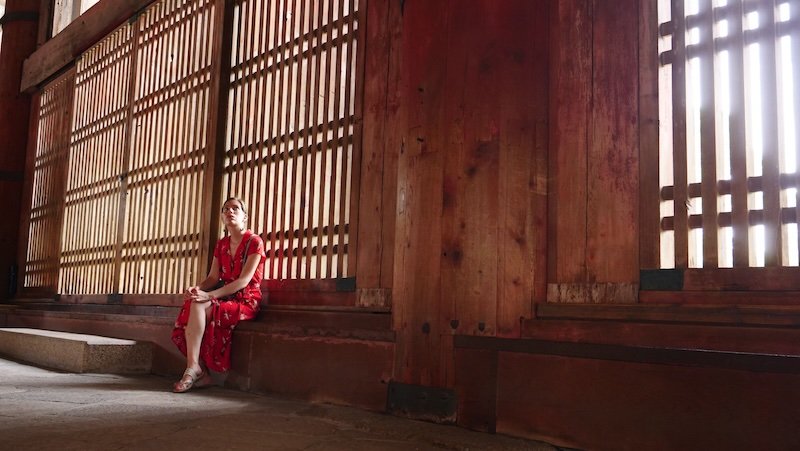
This destination is hardly a well-kept secret and you are guaranteed to find crowds around the main sights, but don’t let that deter you from visiting. There’s something magical about Nara and it truly was one of the highlights of our Japan trip.
For anyone thinking of visiting Nara on a day trip, I’m sharing our 1-day Nara travel itinerary featuring historic temples, secret gardens, and delicious street food!
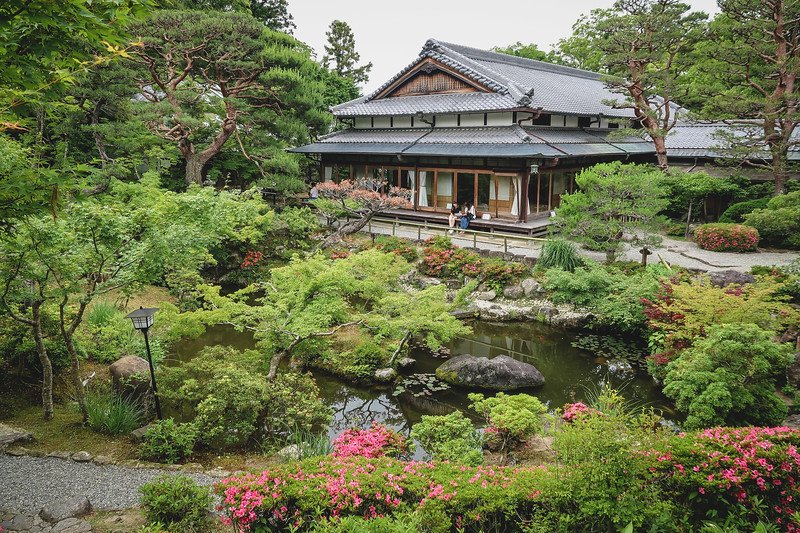
Nara Travel Guide: Things to Do, See, Eat, Drink & Experience in Nara, Japan
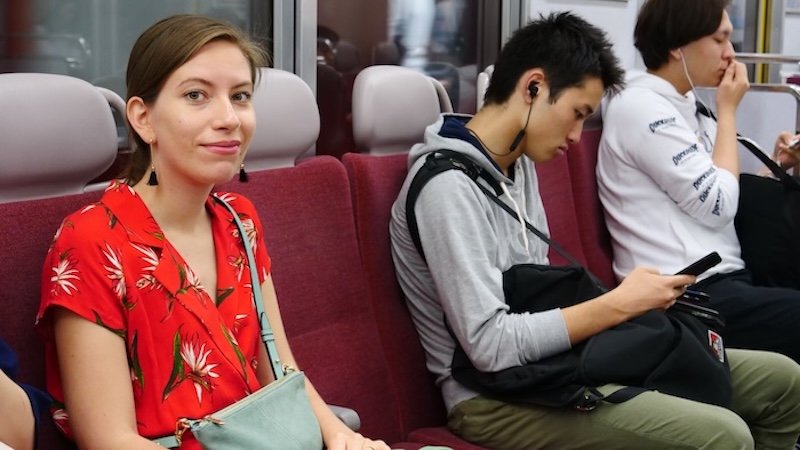
How to get to Nara
Nara is an easy day trip from Osaka and Kyoto with multiple train options to get you there.
From Osaka, you can take the Kintetsu Nara Line departing from Kintetsu Namba Station and arriving at Kintetsu Nara Station.
Or if you have a JR Pass, you can take the JR Kanjo-Yamatoji Lines departing from JR Osaka Station and arriving at JR Nara Station.
We went with the first option since we travelled without a JR Pass.
From Kyoto, you can take the Kintetsu Nara Line departing from Kintetsu Kyoto Station and arriving at Kintetsu Nara Station.
Or if you’re a JR Pass holder, you can take the JR Nara Line departing from JR Kyoto Station and arriving at JR Nara Station – just make sure you get on the express!
You can find more detailed information with travel times and prices here.
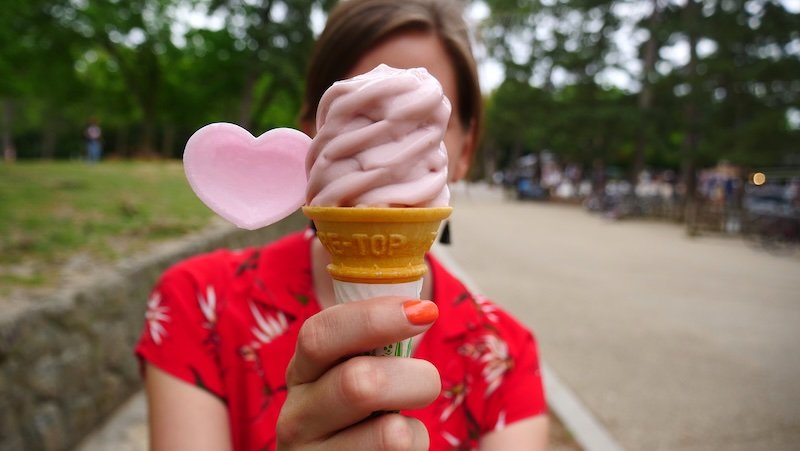
Nara Attractions: How To Make The Most Of Your Day Trip!
Nara Park
Let’s start with Nara Park since this is where many of the city’s attractions are located and where you’re most likely to do your sightseeing.
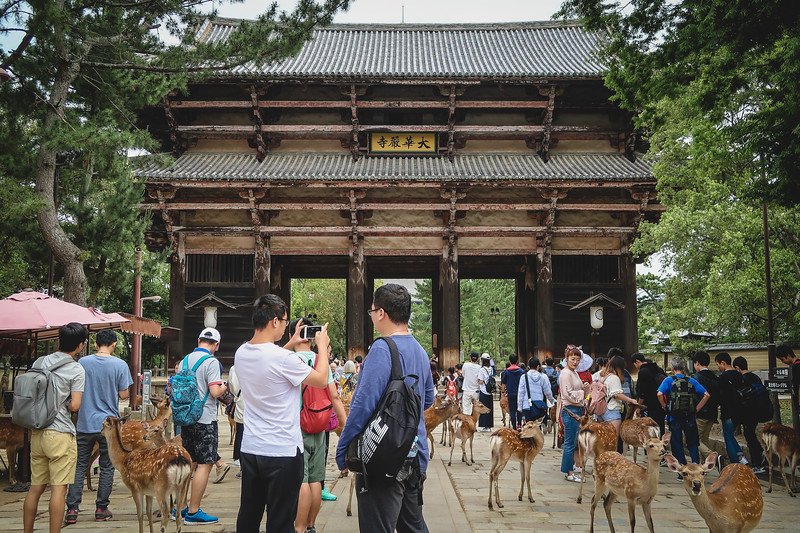
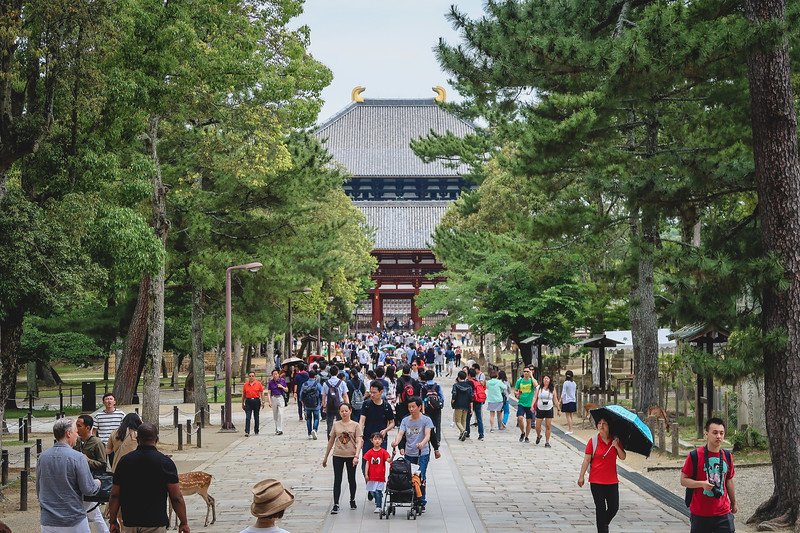
Nara Park was established in 1880, making it one of the oldest parks in Japan, and it covers a total of 660 hectares, meaning there’s a lot to explore.
Within this public park, you’ll find temples, shrines, museums, and walking trails.
The park also happens to be home to around 1200 sika deer who roam freely, but we’ll get to the deer in a bit.
For now, know that admission to the park is free, though you’ll have to pay for a few select attractions within the park grounds.
Todai-ji
The main attraction in Nara Park is Todai-ji Temple, which was once the world’s largest wooden building. And as though that weren’t impressive enough, this temple also happens to house the largest bronze statue of a Buddha. Imagine that!
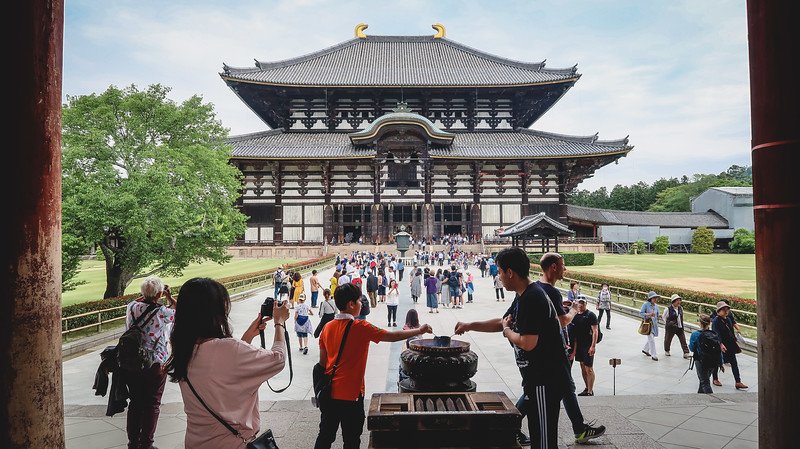
It takes a few moments for your eyes to adjust when you first walk into the temple, as it’s quite dark in there, but then you’re met with this giant bronze statue that stands 15 meters tall and dates back to 752.
Fun fact: they’ve taken x-rays of this statue and there are treasures hidden within it!
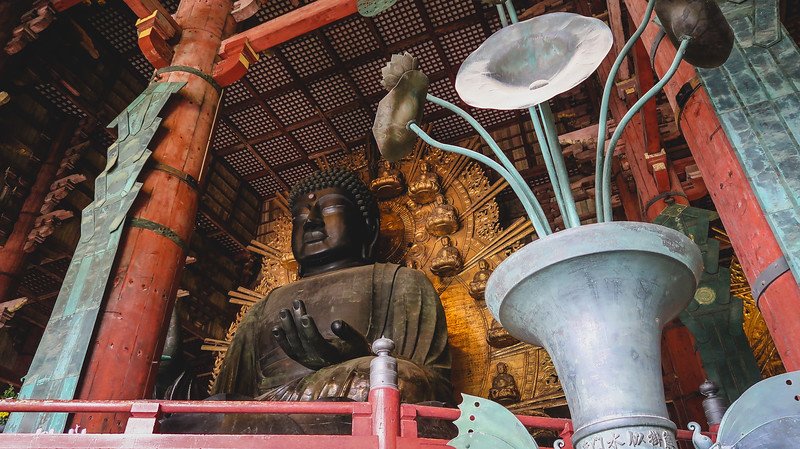
Aside from Todai-ji, we only visited a handful of shrines scattered through the city, but if you’re up for a temple-hopping adventure on your day trip to Nara, here are a few to consider:
- Saidai-ji
- Kōfuku-ji
- Gangō-ji
- Yakushi-ji
- Tōshōdai-ji
- Shin-Yakushi-ji
- Daian-ji
- Enjō-ji
- Ryōsen-ji
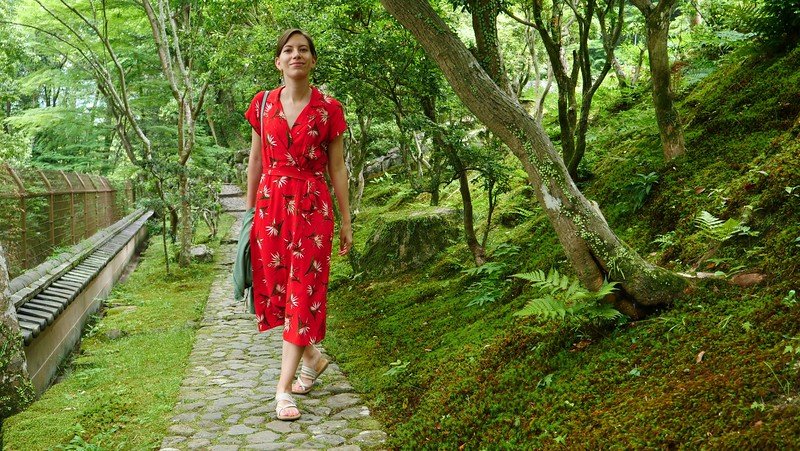
Yoshiki-en Garden
Now for what may be the best-kept secret in Nara, I present to you: Yoshiki-en Garden!
This place wasn’t even on our Nara travel itinerary. We found it completely by chance on our way to Isuien Garden and what really caught our attention was the sign offering free admission to foreign visitors.
It would appear that this place isn’t well-known to international travellers (it certainly wasn’t listed on any guidebooks or blog posts that we read prior to our visit!), because when we reached the ticketing booth, the attendant was quite curious to know how we had found this place (online, from the tourist office, a local’s recommendation).
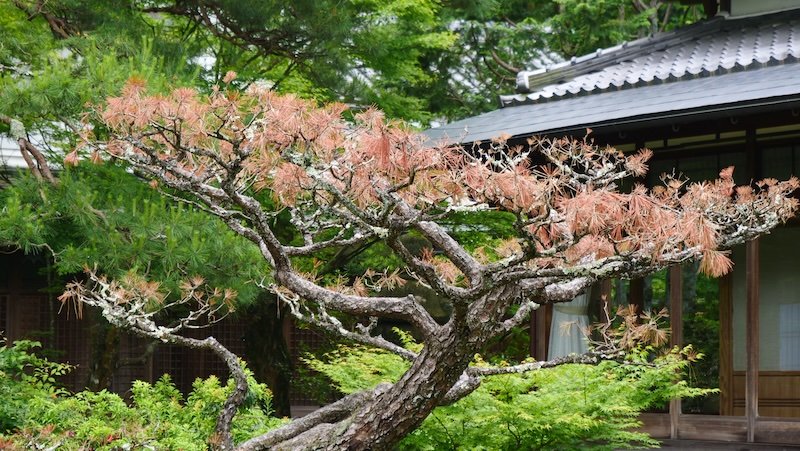
Well, it didn’t take us long to realize that we had stumbled somewhere pretty special. The Yoshiki-en Garden was built on the site of Kofuku-ji Temple’s former priest residences, and it lived up to the image of Japan I had dreamt up in my head.
The garden itself was divided into three different sections: the Pond Garden, the Moss Garden and the Flower Garden.
Since we visited in summer, everything looked so lush and green, and smelled incredibly fresh.
We followed the trail through all three gardens ooh-ing and ahh-ing at every turn.
For me, this garden alone was worth the day trip to Nara!
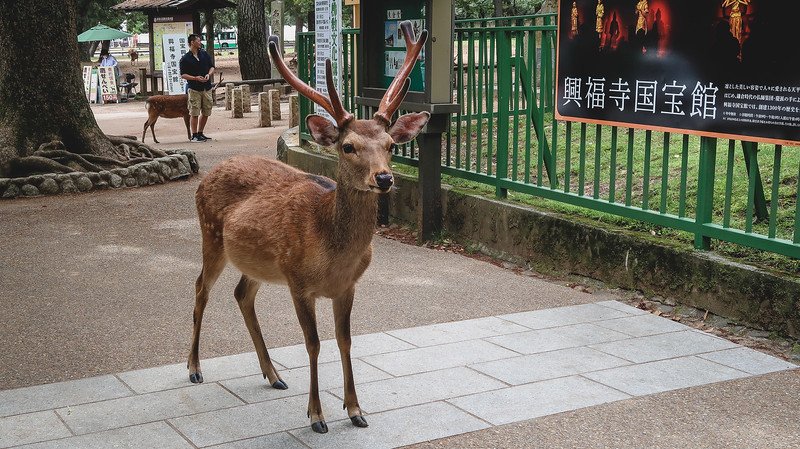
Feeding the bowing deer of Nara
Now let’s talk about the main draw to Nara: the deer!
Nara’s deer hold a very special status in the city. Local folklore has it that Takemikazuchi, the god of thunder, once appeared on Mount Wakakusa (just up the hill from Nara Park) riding a white deer, and thus the deer inhabiting the surrounding forest were deemed sacred messengers of the gods.
Up until 1637, harming a deer was considered a capital offence punishable by death, but after WWII their sacred status was removed, and today they are seen as a national treasure.

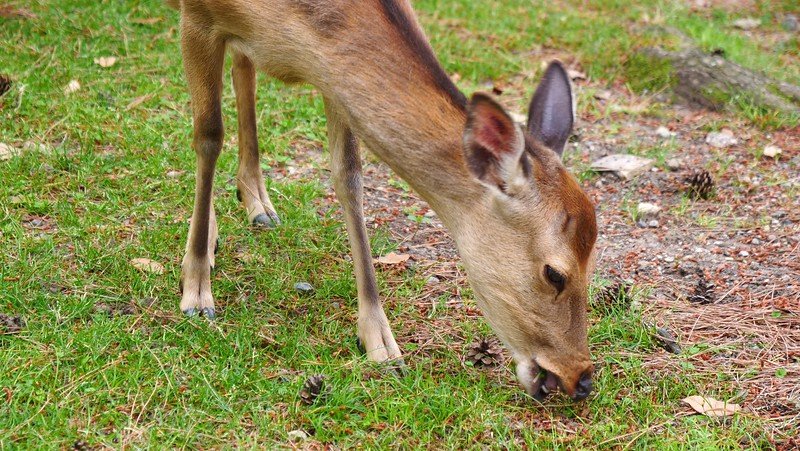
The quickest way to befriend the deer is with treats, and thankfully there are lots of licensed vendors selling crackers specifically made for the deer.
These are called ‘shika senbei’ and you can get them for ¥150.
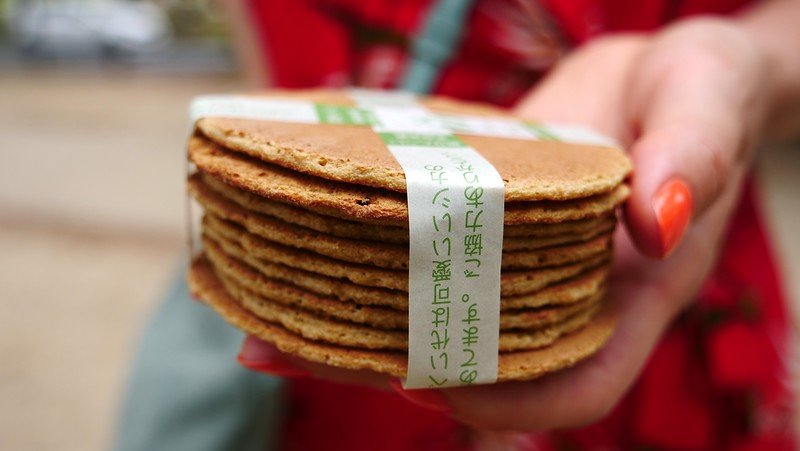
Be warned that the deer can sniff out those crackers whether you stuff them in your pockets or hide them in your bag, so once you have them in hand, prepare for a herd of deer to approach.
The deer are pretty good about bowing – Sam bowed in front of them a few times and then they started doing it too – but I will say that as tame as they are, they can be quite persistent and nip if you’re not feeding them fast enough.
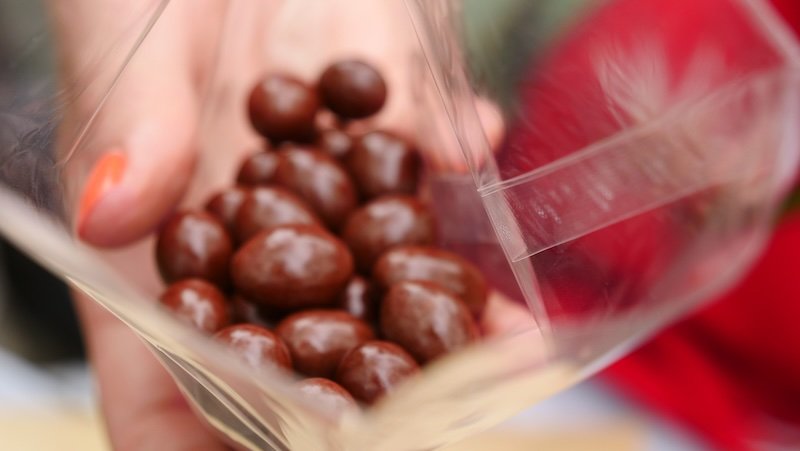
Nara Street Food
A big highlight of our day trip to Nara was all the street food we got to sample!
We did most of our eating around Kintetsu-Nara Station, visiting several shops along Higashimuki Shopping Street, which is a covered pedestrian street, plus we also picked up a few snacks in Nara Park.
If you too are looking to get a taste of Nara, here are some of the street food items we’d recommend:

Mochi / ¥130
For the performance of a lifetime, you need to get freshly-pounded mochi at Nakatanidou.
Men pound the green mochi right before your eyes using fists and big wooden hammers and it’s a complete spectacle.
Contrary to popular belief, this mochi is not matcha flavoured but gets its green colour from mugwort.
It is then stuffed with azuki beans and rolled in roasted soy powder.
The mochi was served warm and it was very soft and light. This was hands down the best mochi we tried in all of Japan!

Persimmon Leaf Sushi / ¥1300
Another street food item unique to Nara is sushi wrapped in persimmon leaves, which is placed in a wooden box and left to ferment a few days. I know this probably doesn’t sound very appetizing, but I assure you, it is!
This tradition of fermented sushi is one that dates back to the times before refrigerators were around, and it was a popular snack to enjoy during the summer festivals.
The original recipe calls for salted mackerel, but these days there’s a greater variety like eel, red snapper and salmon.
We got a mixed box set with both mackerel and salmon and had a little picnic. You can buy these sushi boxes at Kakinohazushi Hiraso Todaiji just outside the train station.

Deer Poop / ¥430
Once you enter Nara Park, you’ll notice a few deer-themed snacks for visitors, including deer poop! These are chocolate covered peanuts, and it’s easy to see how they get their name.
If you’re looking for a fun souvenir to take back home for friends, this one will probably get a few giggles.

Seasonal Soft-Serve Ice Cream / ¥350-400
Another sweet treat that we enjoyed in Nara Park was soft-serve ice cream. They had some seasonal flavours to choose from like sakura and white peach, as well as the classics like matcha, vanilla, strawberry, and chocolate.
I wasn’t too sure about the sakura ice cream (what do cherry blossoms taste like, anyway?), but it was surprisingly sweet with a light floral aroma. Definitely worth trying!

Dorayaki / ¥118
During our visit to Nara, we also tried stuffed red bean pancakes which are known as dorayaki.
The pancakes were very light and fluffy, and we also noticed they had some different fillings like chestnut and sweet potato.

Takoyaki / ¥130
We visited Nara just a few days after arriving in Osaka, so we hadn’t had our fill of takoyaki yet.
These are ball-shaped pancakes filled with octopus, pickled ginger, tempura and green onion.
They are topped with a special sauce that tastes a lot like BBQ sauce, then drizzled with mayo, and sprinkled with bonito flakes.
And of course, we filmed it all, so if you want to see all the sights we visited, the deer we encountered, and the street food we sampled, it’s all here:
Should you stay overnight in Nara?
You certainly could!
We tried to see as much as we could in a day, but Nara Park is massive and we barely scratched the surface in terms of temples, shrines and hiking trails.
If we’d had more time and we’d known how much there was to see, we could have easily allotted 2-3 days. This destination would make the perfect weekend escape or romantic getaway.
If you do decide to stay overnight, Nara has a mix of hostels, hotels and ryokans – the latter is worth experiencing at least once during your travels in Japan!
Ryokans:
- Tsukihitei – a 5-star luxury ryokan located within the Kasugayama Primeval Forest, offering a tranquil setting plus it’s also within walking distance to the shrines (see reviews)
- Koto-No-Yado Musashino – this is Nara’s first ryokan offering a mix of traditional Japanese rooms and Japanese modern fusion rooms (see reviews)
- Kasuga Hotel – a centrally located ryokan overlooking Nara Park close to the train station and restaurants (see reviews)
Hotels:
- Centurion Hotel Classic Nara Station – city hotel close to Nara and Kintetsu-Nara train stations and local eateries (see reviews)
- Super Hotel Lohas JR Nara Eki – central hotel across Nara Station with onsen and buffet breakfast (see reviews)
- Onyado Nono Nara Natural Hot Spring – hotel with hot baths, sauna and an on-site restaurant (see reviews)
Hostels:
- Nara Backpackers – hostel in a traditional Japanese style with a private garden (see reviews)
- Nara Guesthouse 3F – central hostel offering a mix of private rooms and female dorms (see reviews)

Nara Day-Trip Planner: Routes, Timings, Deer Etiquette, Hidden Corners & Practical Tips
A No-Stress 1-Day Nara Itinerary
Best for first-timers coming from Osaka or Kyoto. Adjust the start time to fit your train.
09:00–09:20 — Arrive at Kintetsu-Nara Station (or JR Nara; see comparison below). Grab a quick coffee/snack around Higashimuki Shopping Street.
09:20–10:00 — Stroll into Nara Park via Sanjō-dōri. Keep your camera handy: you’ll meet your first deer within minutes. Skip crackers for now (they’ll follow you).
10:00–11:00 — Tōdai-ji (Great Buddha Hall)
Follow the lantern-lined approach, pass through Nandaimon Gate, and step into the former “largest wooden building in the world” to meet the 15-meter bronze Daibutsu. Allow time to circle the hall and peek at the guardian statues.
11:05–11:35 — Nigatsu-dō terrace (Tōdai-ji complex)
Climb to this wooden veranda for the postcard panorama of Nara Park. It’s usually far quieter than the main hall and gorgeous in any season.
11:45–12:30 — Kasuga Taisha approach
Walk the mossy, lantern-lined path into Nara’s vermilion shrine. The forested approach is half the magic. Pop into the inner area (small fee) if you’d like to see more bronze lanterns and quiet cloisters.
12:35–13:30 — Lunch
Options: casual noodle shop near the shrine, a picnic with kakinoha-zushi (persimmon-leaf sushi) you grabbed earlier, or head back toward Kintetsu for more choice.
13:45–14:30 — Yoshiki-en Garden (free for foreign visitors)
Pond garden → moss garden → flower garden; it’s tiny, contemplative, and seldom busy. If you’re a garden super-fan, add neighboring Isui-en (paid, larger).
14:40–15:10 — Mochi show at Nakatanidō
Watch the swiftest mochi pounding in Japan (seriously) and eat a warm mugwort mochi dusted in kinako.
15:15–16:00 — Naramachi wander
Head into the preserved merchant quarter: lattice-front houses, tiny cafés, little craft shops (think Nara brushes, ink, and deer-themed ceramics). Free to enter Naramachi Koshi-no-Ie (a restored townhouse) if you spot it open.
16:15–17:00 — Deer time (on your terms)
Buy shika-senbei near the park now, when you’re not hustling to a sight. Read the deer tips below (bowing = adorable, but also: they’re food-motivated toddlers with antlers).
17:15–18:00 — Sunset either/or
- Nigatsu-dō for mellow, wide views, or
- Mt. Wakakusa lower slope (gentle incline) for golden-hour grass and city lights.
18:10+ — Dinner near Kintetsu-Nara Station
Higashimuki and Mochiidono shotengai are easy wins for izakaya plates, ramen, curry rice, or…one more soft-serve (sakura if in season!).

Getting to Nara: Kintetsu vs. JR (which one should you ride?)
Both are easy; pick based on where you’re staying and tickets you already hold.
| Feature | Kintetsu Line | JR Line |
|---|---|---|
| From Osaka | Kintetsu-Namba / Osaka-Namba (rapid/limited express options) | JR Osaka / Tennoji (Yamatoji Rapid) |
| From Kyoto | Kintetsu-Kyoto (direct) | JR Kyoto (Nara Line; take the Miyakoji rapid) |
| Arrival station | Kintetsu-Nara (short walk to Nara Park) | JR Nara (a bit farther; ~20 min walk or quick bus) |
| Pass compatibility | Kintetsu passes (regional); not covered by JR Pass | JR Pass (great if you already have it) |
| Pros | Closest to sights; frequent trains; fast from Namba | Free with JR Pass; frequent rapids from Kyoto |
| Cons | Pay out of pocket if you only have JR | Slightly longer walk/bus to the park |

What to See (and how to do it without the crowds)
Tōdai-ji & the Great Buddha (Daibutsu)
- Go early (or late afternoon) for fewer tour groups.
- Don’t rush the outer grounds: Nandaimon’s fearsome Niō guardians are masterpieces.
- Inside, walk the perimeter: the scale of the pillars, the lotus throne, and subsidiary statues reveal themselves slowly.
Kasuga Taisha (lanterns for days)
- The lantern-lined approach through the primeval forest is free and magical even if you skip the inner areas.
- Look for the secondary halls and tucked-away mini-shrines; they’re often empty and photogenic.
- Kasuga Botanical Garden next door blooms with wisteria in late spring.
Nigatsu-dō & Sangatsu-dō (Tōdai-ji sub-temples)
- Nigatsu-dō’s balcony is one of the best free viewpoints in Nara.
- If you’re here in March, ask about the Omizutori fire ceremony period (intense, popular, unforgettable).
Yoshiki-en vs. Isui-en (which garden is “you”?)
| Garden | Size & Feel | Highlights | Good If |
|---|---|---|---|
| Yoshiki-en | Small, serene, free for foreign visitors | Moss garden, pond reflections, flower beds | You want calm + quick + pretty |
| Isui-en | Larger, layered, paid | Borrowed scenery of Wakakusa, teahouses, art museum tie-ins | You’re a garden buff & have 45–60 minutes |
Naramachi (old merchant quarter)
- Peek into Koshi-no-Ie (free heritage townhouse) if open.
- Browse small studios for Nara brushes, ink sticks, deer-motif textiles, handmade chopsticks.
- Cafés here are slow-life sweet spots—perfect mid-afternoon rest.
Mt. Wakakusa (Wakakusayama)
- The lower slope is an easy add after Kasuga Taisha; sunsets can be lovely.
- In mid-winter, the hill is famously set ablaze during Wakakusa Yamayaki (see seasonal section).

Nara Food Trail (snack like a pro)
Street-Food Bingo Near Kintetsu & Nara Park
- Mochi @ Nakatanidō (warm, mugwort, kinako—watch the hammer show!)
- Kakinoha-zushi (persimmon-leaf wrapped sushi) for a picnic; classic mackerel or mixed boxes
- Dorayaki (red bean pancakes) + seasonal versions (chestnut, sweet potato)
- Takoyaki (octopus balls) with bonito snowing on top
- Soft-serve (sakura in spring, white peach in summer, matcha year-round)
- “Deer poop” chocolates (yes, they’re peanuts; yes, great gag gift)

Sit-Down Ideas
- Udon or soba around the shrine area (fast, comforting, budget-friendly)
- Izakaya near Kintetsu for shared plates after sunset
- Traditional sweets (wagashi) with matcha in a teahouse by the gardens
Vegetarian / Vegan Notes
Noodles (kitsune udon), plain onigiri, vegetable tempura, tofu dishes, and sweets are easy wins. Always confirm broth (fish stock is common).

Deer Etiquette & Safety (read this before you give them crackers)
The deer are delightful—and opportunists. To keep it cute (and safe), follow this:
- Buy only licensed shika-senbei. Human food is a no.
- Feed in open space. Avoid corners/benches that box you in.
- Hold crackers high, break into small pieces. No pockets rummaging!
- Bowing works. Bow → deer bows → offer a piece. (Magic.)
- Watch for “tells.” Ears flat, head tossing = too pushy; step away calmly.
- Guard loose items. They’ll nibble maps, bags, dangling scarves.
- Kids & strollers: Keep a crack-free zone; let little ones watch first.
- Spring caution: Mothers with fawns are protective; keep space.
- Hand hygiene: Bring sanitizer/wipes.
Mini-checklist
- Crackers unwrapped only when ready
- Valuables zipped in bag
- Shoes tied (yes, they’ll tug laces)
- Photos first, feeding second

Seasons in Nara (what’s special when you go)
Spring (Mar–May)
- Cherry blossoms across Nara Park (late Mar/early Apr peak most years).
- Wisteria trellises in Kasuga’s botanical garden (late April–May).
- Weather: mild; pack a light jacket and an umbrella.
Summer (Jun–Aug)
- Lush greens in every garden; shady shrine approaches.
- Nara Tōkae (August): thousands of candles glow across the park at night—stunning.
- Hot/humid afternoons—go early, siesta, then come back for evening light.
Autumn (Oct–Nov)
- Momiji (maples) flame red around the gardens and Nigatsu-dō approach.
- Crisp air; golden gingko leaves—photographers’ dream.
Winter (Dec–Feb)
- Quiet trails; occasional dustings of snow.
- Wakakusa Yamayaki (late Jan): hill-burning festival with fireworks (one evening only; dates vary).
- Chilly; bring layers, hat, and hand warmers.

Tickets, Fees & Time Savers
- Tōdai-ji (Great Buddha Hall): Small entrance fee (bring cash). Go early/late to avoid queues.
- Kasuga Taisha inner area: Modest fee; the forest approach is free.
- Yoshiki-en: Free for foreign visitors (show passport/ID).
- Isui-en: Paid (sometimes combined with small museum).
- Nigatsu-dō terrace: Free.
- Buses: Flat fares on Nara Kōtsū around the core sights; tap-to-pay IC cards accepted.
- Lockers: At both JR Nara and Kintetsu-Nara—ideal for day-tripping with luggage.
Money stretchers
- Pack a water bottle; refill at vending machines/shops.
- Aim for noodles/lunch sets mid-day; street snacks fill the gaps.
- Choose one paid garden if watching the budget (Yoshiki-en free helps).
Should You Stay Overnight in Nara?
| Stay Length | Pros | Consider If |
|---|---|---|
| Day trip | Perfect “first taste”; easy from Osaka/Kyoto | You’re short on time or on a Golden Triangle sprint |
| 1 night | Quieter evenings; garden/shrine visits in soft light; onsen/ryokan stay | You love slow travel, want sunrise/sunset photos, or are visiting during a festival |
| 2–3 nights | Hikes, museum time, deep Naramachi wanders, brewery tastings | You’re making Nara a romantic or slow-weekend base |
If you stay: Consider a ryokan for the full tatami + kaiseki experience, or modern hotels near the stations for convenience.
Packing & Practicalities (Nara edition)
Essentials
- Comfortable walking shoes (you’ll do 10–20k steps)
- Lightweight rain layer/compact umbrella
- Reusable bottle + a small tote for snacks/souvenirs
- Tissues/hand wipes (some toilets have no paper; deer feeding)
- Cash for small shrines/snacks/lockers
- Portable charger (photo days drain phones)
- Seasonal adds: sunhat in summer; warm layers in winter
Navigation
- Download an offline map centered on Kintetsu-Nara, with pins for Tōdai-ji, Kasuga Taisha, Nigatsu-dō, Yoshiki-en/Isui-en, Nakatanidō, Naramachi.
Safety & etiquette
- Keep voices low in shrine/garden areas.
- Walk bikes in inner shrine approaches.
- Dispose of trash properly; bins are scarce—use convenience stores.
Build-Your-Own Nara (choose 1 from each row)
| Theme | Option A (Classic) | Option B (Quiet) | Option C (Tasty) |
|---|---|---|---|
| Big sight | Tōdai-ji | Kasuga Taisha (inner precincts) | Tōdai-ji + quick hall loop |
| View | Nigatsu-dō | Wakakusa lower slope | Nigatsu-dō at sunset |
| Garden | Yoshiki-en | Isui-en | Skip garden; add Naramachi café |
| Culture | Naramachi townhouse | Small museum near Isui-en | Brewery tasting in town |
| Food | Mochi + kakinoha-zushi | Matcha + wagashi | Takoyaki + soft-serve |

Rapid Fire Info
JR Pass or pay Kintetsu?
If you have a JR Pass already, JR is great. If not, Kintetsu usually puts you closer to the action.
How much time for Tōdai-ji?
Plan 60 minutes for the gate + hall; more if you love details.
Can I feed deer anything else?
No—only licensed shika-senbei. Human food and plastic are harmful.
What if a deer gets pushy?
Show hands (no food), step away calmly, put something solid between you (tree/fence), and wait them out.
Is there luggage storage?
Yes—coin lockers and luggage desks at both JR and Kintetsu stations.
Where’s the best free view?
Nigatsu-dō balcony. No ticket, big payoff.
I only have half a day—what’s the must-do trio?
Tōdai-ji, Nigatsu-dō viewpoint, mochi at Nakatanidō (+ a quick deer hello).
Nara Day Trip FAQ: Timing, Trains, Deer Etiquette, Gardens, Food & Photo Spots (12 Essential Q&As)
What’s the simplest way to get to Nara for a day trip from Osaka or Kyoto?
If you already hold a JR Pass, ride the JR lines (Yamatoji Rapid from Osaka or Miyakoji Rapid from Kyoto) to JR Nara. Otherwise, the Kintetsu Line is usually faster and drops you closer to Nara Park at Kintetsu-Nara—perfect for walking straight into the sights.
How early should I start, and how much can I realistically see in one day?
Aim to arrive by 9:00 a.m. You can comfortably cover Tōdai-ji, Nigatsu-dō, Kasuga Taisha’s forested approach, Yoshiki-en Garden, a Naramachi wander, and some deer time—with snack breaks built in. Sunset at Nigatsu-dō or Mt. Wakakusa is a mellow finale.
If I only have half a day, what’s the must-do trio?
Go for the Nandaimon Gate + Tōdai-ji (Great Buddha Hall), the Nigatsu-dō viewpoint, and a quick mochi stop at Nakatanidō—plus a brief “hello” to the deer on your way.
Where should I meet (and feed) the famous bowing deer—and how do I do it safely?
You’ll meet them all around Nara Park. Buy licensed shika-senbei from vendors, bow first, then offer a small piece. Feed in open spaces, keep bags zipped, and step away calmly if a deer gets pushy (ears flat or head tossing = take a breather).
Can kids enjoy Nara, or are the deer too feisty?
Kids usually love Nara, but treat deer like food-motivated toddlers. Keep little ones at arm’s length, feed in open areas, and skip feeding entirely if anyone feels nervous. Watching others feed is just as fun.
What’s the best crowd-beating strategy for Tōdai-ji and Kasuga Taisha?
Do Tōdai-ji right at opening (or late afternoon), then wander to Nigatsu-dō for a quieter terrace view. For Kasuga Taisha, the lantern-lined forest approach itself is free, photogenic, and often calmer than the inner precincts.
Yoshiki-en vs. Isui-en: which garden should I pick?
Yoshiki-en is small, serene, and free for foreign visitors—great for a quick, contemplative stop. Isui-en is larger (paid) with classic tea-house views and “borrowed scenery” of Mt. Wakakusa—choose it if you’re a garden devotee with 45–60 minutes.
What street foods should I not miss near the park and Kintetsu-Nara?
Grab freshly pounded mugwort mochi at Nakatanidō, kakinoha-zushi (persimmon-leaf sushi) for a picnic, takoyaki, dorayaki, seasonal soft-serve (sakura in spring!), and cheeky “deer-poop” chocolates (they’re peanuts).
When is the best season to visit Nara?
Spring brings cherry blossoms and wisteria; summer is lush (and the Nara Tōkae candle festival glows in August); autumn pops with maples; winter is quiet, with Wakakusa Yamayaki (late January hill-burning + fireworks) on one evening.
Where’s the best free viewpoint for photos?
Nigatsu-dō’s balcony wins for wide, dreamy views over rooftops and trees—no ticket required. For a grassy golden hour, stroll the lower slope of Mt. Wakakusa.
Is there luggage storage and easy local transport?
Yes—coin lockers (and desks) at both JR Nara and Kintetsu-Nara. In town, Nara Kōtsū buses connect major sights, and IC cards tap in/out seamlessly.
Should I stay the night, or is a day trip enough?
A day trip is a perfect first taste. If you stay one night, evenings and early mornings are blissfully calm for shrines and gardens—plus you can try a ryokan with onsen and kaiseki for the full experience.
Have you visited Nara?
What else would you add to this Nara 1 day travel itinerary?

My boyfriend and I are planning a trip to Japan next year, and Nara is definitely on the list! Loved this post, and I’m looking even more forward to visiting this city, and Japan in general 🙂
Nara looks like a fun place, and I love your red dress 🙂
Once you arrived Nara. Are all the places in one space. Allowable to walk to each other?
Yes, it’s walkable. We visited all of these places on foot, however, we did notice bike rentals if you want to cover more ground on a day trip to Nara.